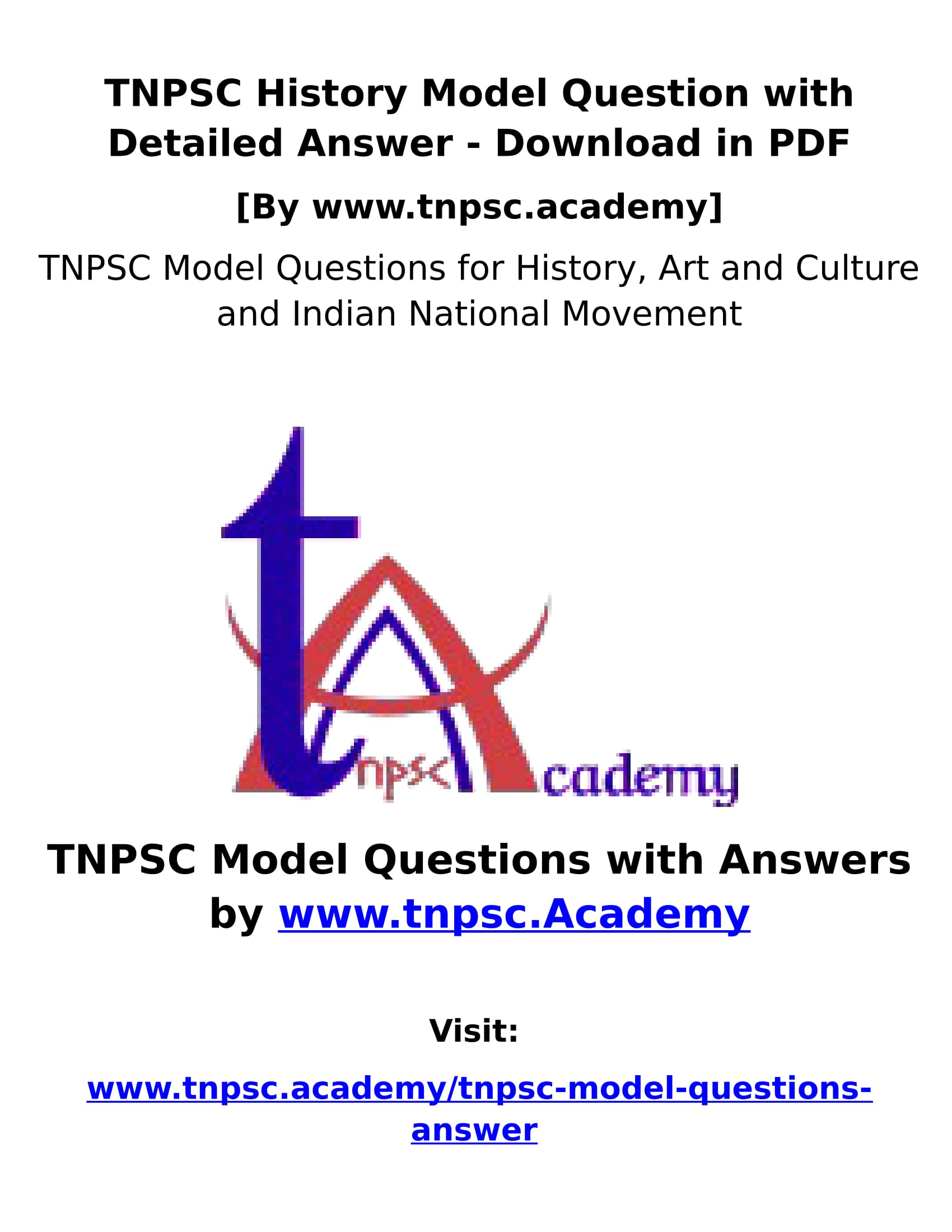
[vc_row][vc_column][vc_column_text] Download Question in PDF Download Detailed Answer in PDF Attend Online Test
TNPSC History Model Question with Detailed Answer-1 Details:
No. of Questions : 20
Marks : 30
Note : Detailed answers for the questions are given below each question. If any of the answers are not displaying, try by reloading the page.
For More TNPSC Model Question Paper with Detailed Answer –>>
[/vc_column_text][/vc_column][/vc_row][vc_row][vc_column][vc_column_text]1. The term ‘Harappa’ in sindhi means?
a. Burnt brick
b. Mound of dead
c. Buried city
d. None of the above
c. Buried City
(Std 6 – Indus Valley Civilisation)
Harappa in Sindhi means ‘Buried City’. Mohenjo-Daro in sindhi means ‘Mound of Dead’. Burnt Brick was used by Harappans for construction in the town.
2. For making ornaments and other usage, the Indus people used
I.Gold II. Silver
III. Ivory IV. Iron
Choose the correct answer
a. I, II and IV only
b. I, II and III only
c. I, III and IV only
d. III and IV only
b. I, II and III Only
(Std 6 – Indus Valley Civilisation)
Iron was not known to the Harappan people. To make ornaments, they used Gold, Silver, Ivory and precious stones and also ornaments out of shells and copper. Both men and women wore many ornaments.
3. The Tamil language spoken in Tamil Nadu can be appreciated as like following except
a. Senthamizh
b. Nattutamizh
c. Paeynthamizh
d. Muthamizh
b. Nattutamizh
(Std 6 – Ancient Tamil Nadu)
4. The river that was said to have flown on the landmass of ancient ‘Kumari Kandam’ was
a. River Saraswathi
b. River Cauvery
c. River Meghna
d. River Fahruli
d. River Fahruli
(Std 6 – Ancient Tamil Nadu)
Before prehistoric period, the Indian Ocean on the south of Cape Comorin was a land mass. It was called as ‘Kumari Kandam’. The river Fahruli ran on this land mass which was eight to ten times bigger than South India. Whereas river Saraswathi was an ancient river thought to have existed in the North-West India.
Current Affairs about river Saraswathi:
https://www.tnpsc.academy/tnpsc-current-affairs-oct-18 2016-18102016/
5. The Chola ruler who merged the Chalukya kingdom with the Chola Empire and started the Chalukya-Chola line of rulers was
a. Kulothunga Chola
b. Raja Raja Chola
c. Rajendra Chola
d. Vijayalaya Chola
a. Kulothunga Chola
(Std 7 – The Kingdom of Deccan)
Vishnu Vardhana, a brother of Pulakesin-II, was the founder of the Eastern Chalukya Empire of Vengi. One of their descendents namely Kulothunga Chola (1071 – 1122 A.D) was enthroned as a Chola ruler.
Vijayalaya Chola founded the Imperial Chola Empire. Raja Raja Chola built the famous Brihadishwara temple in Tanjore. Rajendra Chola made expeditions to Srilanka and other Islands.
6. The First Battle of Tarain (1911 A.D) was fought between Rajput ruler Prithviraj Chauhan and
a. Mahmud of Ghazni
b. Muhammad of Ghori
c. Qutb-ud-din Aibak
d. Babur
b. Muhamma of Ghori
(Std 7 – Arab and Turkish Invasion)
In 1189 A.D Muhammad of Ghori captured the fortress of Bhantida and advanced into the kingdom of Prithviraj Chauhan, the Rajput ruler. Prithviraj Chauhan with a large force won the battle and also recaptured Bhantida (First battle of Tarain 1191 A.D).
In 1192 A.D, in the Second battle of Tarain, Muhammad of Ghori defeated the combined forces of the Rajput rulers under Prithviraj Chauhan. Muhammad of Ghori appointed Qutb-ud-din Aibak as his commander. This was the start of Slave dynasty.
7. The followings are the Architectural styles of Pallava rulers except
a. Rock Cut temples
b. Monolithic Rathas and Mandapas
c. The Structural Temples
d. Vihara styles
d. Vihara Style
(Std 7 – South Indian Kingdom)
Rock Cut temples introduced by Mahendravarman – I were excavated at places like Mahendravadi, Mammandur, Dalavanur, Thiruchirappali, Syamangalam, Thirukazhukundram, etc. The Monolithic Rathas and Mandapas were found at Mamallapuram. The Structural temples in the Rajasimha Style were found at Kailashnath temple at Kanchi, Shore temple at Mamallapuram.
Vihara is the name of Buddhist Monastry.
8. In the context of administration of Mughal Empire, match the following
A. Diwan-i-Wizarat – 1. Minister for Communication
B. Diwan-i-Ariz – 2. Foreign Minister
C. Diwan-i-Rasalat – 3. Revenue and Finance
D.Diwan-i-Insha – 4. In Charge of Army
Choose the correct option
A B C D
a. 3 4 2 1
b. 3 4 1 2
c. 1 3 4 2
d. 1 3 2 4
a. 3 4 2 1
(Std 11 – Mughal Empire)
These administrative setup was introduced by emperor Sher Shah sur and was followed by Mughal rulers and most effectively by Akbar.
9. The famous Angkor wat (temple) in Cambodia was built by which of the following South Indian Ruler?
a. Mahendravarman I
b. Suryavarman II
c. Yasovarman I
d. Narasimhavarman II
b. Suryavarman II
(Std 11 – The Spread of Indian Culture in Other Asian Countries)
Yasovarman and Suryavarman II were two well-known rulers of Kambhoja kingdom (Cambodia). Here Temples were built in South Indian style. There are plenty of Sanskrit inscriptions. The most famous of these temples was the temple (wat) of Vishnu built by Suryavarman II in his capital city Angkor. It was popularly called as the Angkorwat Temple. It is standing on top of a terraced structure. Each terrace is a sort of a covered gallery which contains numerous relief sculptures. The temple is constructed on the Dravidian style and the sculptures depict episodes from the Ramayana and the Mahabharata
10. The 13th century Bakthi saint Ramanuja preached
a. Dvaita
b. Jivatma
c. Vishistadvaita
d. None of the above
c. Vishistadvaita
(Std 11 – Bakthi movements in Medieval India)
In the twelfth century, Ramanuja, who was born at Sriperumbudur near modern Chennai, preached Visishtadvaita. According to him God is Sagunabrahman. The creative process and all the objects in creation are real but not illusory as was held by Sankaracharya. Therefore, God, soul, matter are real. But God is inner substance and the rest are his attributes. He also advocated prabattimarga or path of self-surrender to God.
In the thirteenth century, Madhava from Kannada region propagated Dvaita or dualism of Jivatma and Paramatma.
11. As a part of Swadeshi Movement in Tamil Nadu, V.O.Chidambaram Pillai launched the Swadeshi Steam Navigation Company in the year
a) 1905 b) 1906
c) 1907 d) 1908
b. 1906
The Partition of Bengal in 1905 led to the beginning of Swadeshi Movement in all over India. The important leaders of Swadeshi movement in Tamil Nadu were V.O. Chidambaram Pillai, Subramania Siva and Subramania Bharathi. The Swadeshi Steam Navigation Company was started as an competition to the British India Steam Navigation Company in Tuticorin.
12. The Vaikom Satyagraha in Kerala was launched by
a. Rajagopalachari
b. Satyamurthi
c. Subramanya Siva
d. Periyar E.V.R
d. Periyar E.V.R
The Vaikom Satyagraha was a movement in Travancore (Kerala) against social segregation (especially untouchablity) in the year 1924-25.
13. The Chera ruler who founded the famous Pattini cult was
a. Nedum Cheralathan
b. Kulashekara Varma
c. Rajashekara Varma
d. Cheran Senguttavan
d. Cheran Senguttavan
Pattini cult was related to worship of Goddess of Chastity Kannagi. Cheran Senguttuvan is said to have invaded the north and even crossed the Ganges.
14. The only surviving work of Second Sangam is
a) Tolkappiyam
b) Ettuthogai
c) Pattupattu
d) No works survived second Sangam as like first Sangam.
a. Tolkappiyam
The First Sangam was convened at Thenmadurai and no works have survived. The surviving works of Third Sangam were Ettuthogai, Pattupattu and Pathinenkizhkanakku noolgal.
15. The Indo-Greek ruler Menander was converted to Buddhism by
a) Badrabahu
b) Nagasena
c) Amogavarsha
d) Vasumitra
b. Nagasena
Badrabahu was the Jaina saint who was followed by the Mauryan ruler Chandragupta Maurya. Amogavarsha and Vasumitra were patrons in the court of Kanishka.
16. The First session of the Indian National Congress was held at
a. Calcutta
b. Nagpur
c. Belgaum
d. Bombay
d. Bombay
(Std 10 – Freedom Movement in India Phase I)
The Indian National Congress was founded in the year 1885 under the advise of Allan Octavian Hume, a retired British Civil Servant. W.C.Bannerjee chaired the first session of Indian National Congress.
Mahatma Gandhi was the president of Indian National Congress at only one time at Belgaum in 1924.
17. Find the Odd man out.
a. Surendranath Banerjee
b. Dadabai Naoroji
c. Gopala Krishna Gokhale
d. Bipin Chandra Pal
d. Bipin Chandra Pal
(Std 10 – Freedom Movement in India Phase I)
Bipin Chandra Pal was on the Extremist side of Indian National Congress. Were as, the others were Moderates.
The important extremist congress leaders were Lokmanya Bal Gangadhar Tilak, Bipin Chandra Pal, Lala Lajpat Rai and Arabind Ghosh.
(Shortcut to remember: Bal – Pal – Lal)
18. The Home Rule League was established at Madras by Annie Besant in
a) June 1916
b) September 1916
c) June 1917
d) September 1917
b. September 1916
(Std 12 – Indian National Movement Phase II)
Two Home Rule Leagues were established, one by B.G. Tilak at Poona in April 1916 and the other by Mrs. Annie Besant at Madras in September 1916. The aim of the Movement was to get self government for India within the British Empire. It believed freedom was the natural right of all nations
19. Mahatma Gandhi was the editor of which of the following
a) Indian Opinion
b) Harijan
c) Young India
d) All of the above
d. All the above
Indian Opinion: 1903 – 15
Harijan : 1919 – 31
Young India: 1933 – 42
His literary works include Hind Swaraj (1909), My Experiments with Truth (1927).
20. The Indian National Congress represented by Mahatma Gandhi attended the
a. First Round Table Conference
b. Second Round Table Conference
c. Third Round Table Conference
d. Gandhi didn’t attend any Round Table conferences.
b. Second Round Table Conference
Congress launched the Civil Disobedience Movement in 1930. As a part of it, Gandhi led the Salt Satyagraha (Dandi march) in March 12, 1930. The British convened the First Round Table Conference in Nov 1930. No one from INC attended it and hence it was not successful.
Gandhi-Irwin Pact was signed in March 1931 and hence Gandhi accepted the invitation of British to attend the Second Round Table Conference (Sep to Dec 1931).
Disappointed with the issue of Communal Award, Gandhi again started the Civil Disobedience Movement after returning from Second Round Table Conference (London). Hence no one from INC attended the Third Round Table Conference (Nov to Dec 1932)
[/vc_column_text][vc_column_text]TNPSC history model question paper with detailed answer. Read and Download tnpsc history model question. Also read and download tnpsc model question paper and answer.[/vc_column_text][/vc_column][/vc_row]
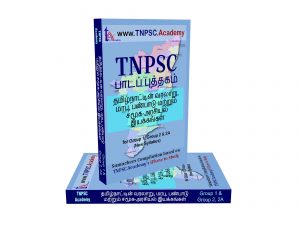









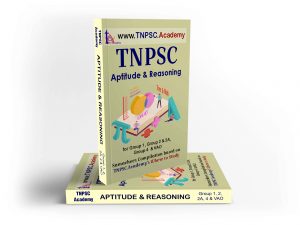








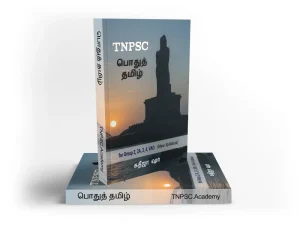
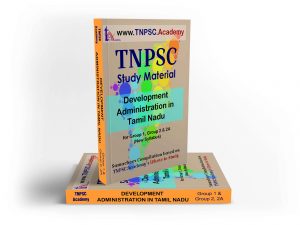


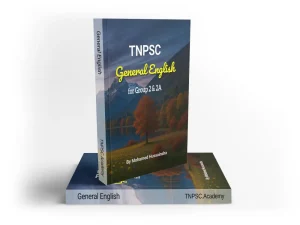


very informative…
useful for who seeks knowledge ..
very informative…
Heartful Thanks. You are making thousands of govt employees annually 🙂